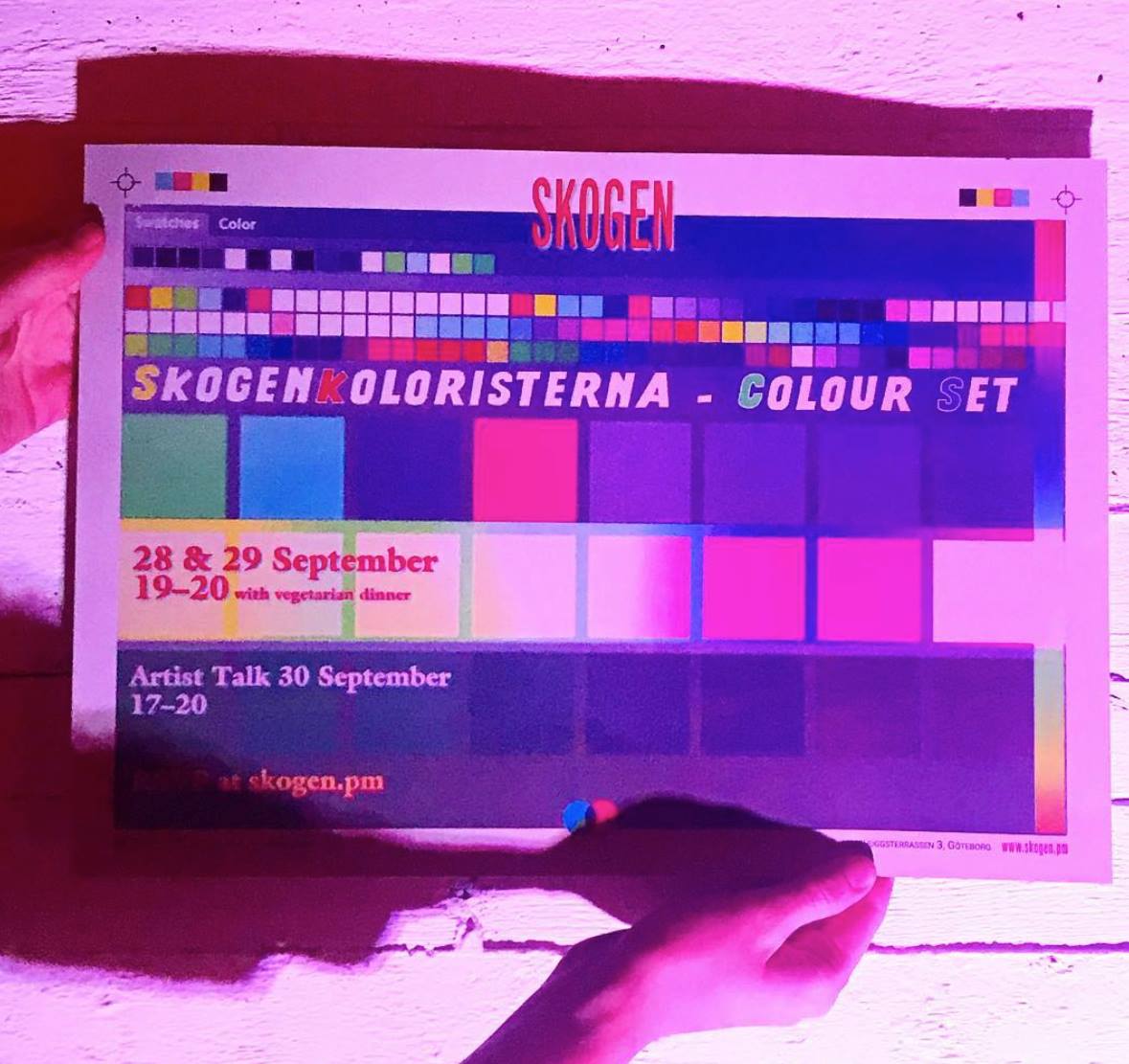
The Skogen Koloristerna is a group of artists and colour, pigments, dyes and light enthusiasts that participated in the study group “Chromatic Materials and Hallucinations: Towards the Skogenkoloristerna” at the Skogen
The group formed by André Alves, Rachel Barron, Amanda Björk, Geraldine Juárez, Ulf Rönnerstrand, Lucy Wilson has remediated their colour research and experiments in the performance piece Colour Set.
Colour Set uses the structure of commercial colour sets (containing different types of colours such as aquarell, crayons, pastels, crayons and colour pencils) as spatial framework to perform materials, histories, technologies, politics and poetics of colour and its transformation into management systems.
Colour Set induce colour experiences using chromatic materials and mixing them with different types of mediums such as video, voice, sound, painting and acting.
For Colour Set, I developed a narration and light performance titled "Violet/Ultraviolet" on colour, on vibration, and on love.
Violet/Ultra-violet
André Alves
Violet is the highest frequency of the spectrum of visible light.
The rays beyond the visible spectrum of violet are called ultraviolet light, or U.V. They are not visible to the human eye, but can be sensed, since they warm the surfaces they touch. They can even burn, if touching for a long time.
For humans, excessive contact with ultra-violet radiation can produce acute and chronic harmful effects, especially to the eye, for too long exposure can result in sight impairment. And this is a conflicting idea, given the fact that ultra-violet is what the eye can’t see.
There are of course ways to “see” ultra-violet. Some materials have the special property of absorbing ultra-violet light and then re-emitting the light, but at lower frequency, and in this way, making it visible. This property is called "fluorescence."
In 1934, Joe and Emmet Switzer, while developing experiments to use in magic shows, found a way to filter Ultra-violet. By turning Ultra Violet’s invisible energy into visible light, things would seem to glow. They had just invented the first black-light, also known as the UV-A, and later, developed dyes prone to glow, which they patented as Day-Glo. The uses of ultra-violet sensitive dyes became widespread in later decades, from money marking to a certain aesthetics connected to the discotheque and the hallucinogenic of drugs. UV colour is a trip outside the constraints of our perception.
Since we’re speaking of things beyond perception, the colour violet has relation with another beyond-perception phenomenon; one that warms-up when touches you, makes you glow or burn. That phenomenon is either called lust or love.
For a long time, it was believed by alchemists, that love, more than the effect of neurotransmissions in the body, exists beyond the senses and that it could be extracted, for instance, from plants. It was believed that such perfume could be extracted from the violet flower, that gives name to the colour.
Breathe in…
[sound of inhaling]
The scent you might feel by now is the perfume of violets… but don’t be apprehensive: you see, the scent of violet is like ultra-violet light, something that involves a sense of magic. It is known for coming and going, coming and going… like vertigo, like love, like lust. And this is not just a metaphor, because the most noteworthy chemical component of violet’s aroma is ionone.
[sound of inhaling]
After stimulating your scent receptors, ionone binds to them, making them numb, insensitive. The brain simply cannot register scent while the receptors are numb. After a while, the scent comes back, but the brain cannot tell that this is the same scent and registers it as a new stimulus. And this is why the scent of violet feels it is coming and going, like vertigo, like love, like lust. It is no surprise that violets are called “forget me not.”
In 2018, the colour company Pantone designated Ultra-violet the colour of the year. According to the company, the choice of colour of the year is supposed to reflect the current cultural climate. The choice is philosophical, in the sense that it is all about getting you to look at a colour in a new way. If this beyond-violet, this ultra-violet is supposed to reflect the world (a colour which humans can’t see directly, and which contact one ought to be cautious), then, one must take it as reflex of a year of invisible things; a year of cautionary contacts, of things that touch you but you can’t hold memory of… it might be important to recall how the early experiments of the Switzer brothers with Ultra Violet, were initially tied to illusion, and how their first customers were spiritualists who used the glow-in-the-dark dyes to give evidence to their clients of communicating with the beyond.
What is beyond the violet, not only is out of perception, but is also full of senses of beyond, and of our limitedness: we want to see the colours we cannot see, to have in us the love that is outside of us. It is in this sense that violet is a reminder of our own confinement, that we have to develop that brain potentiality of seeing more colour spectrum, smelling more, seeing energy flowing rather than just sensing it, feeling it